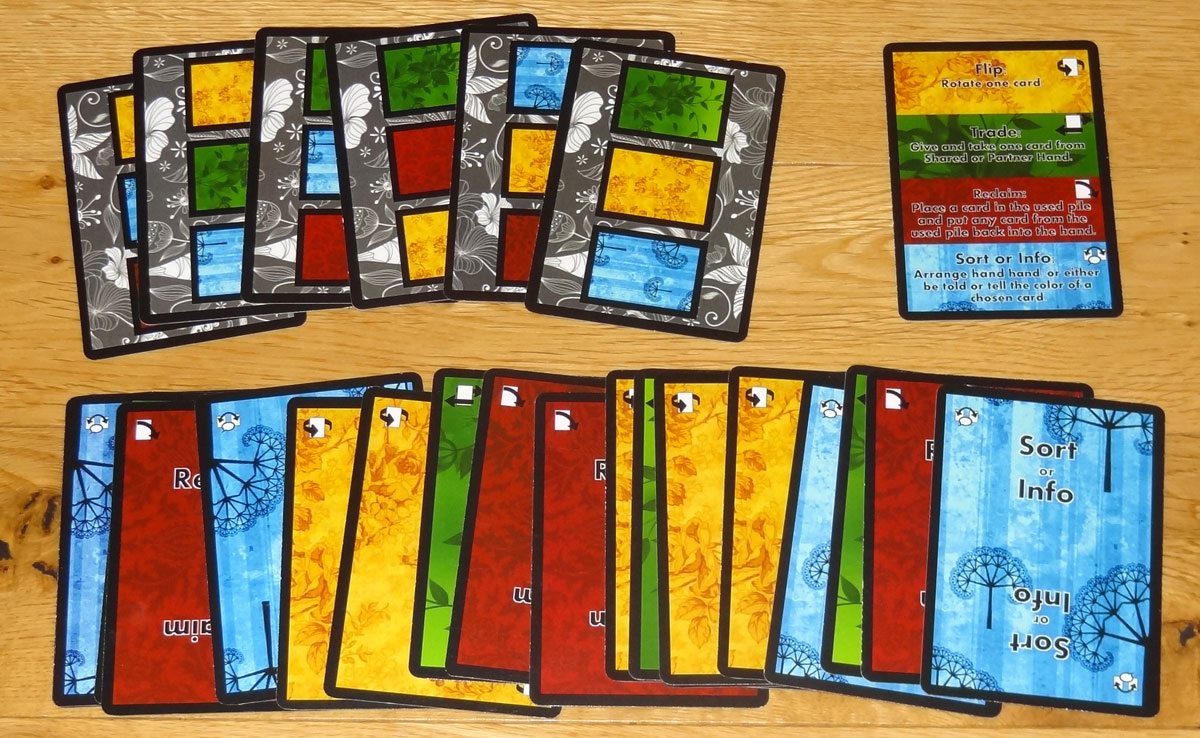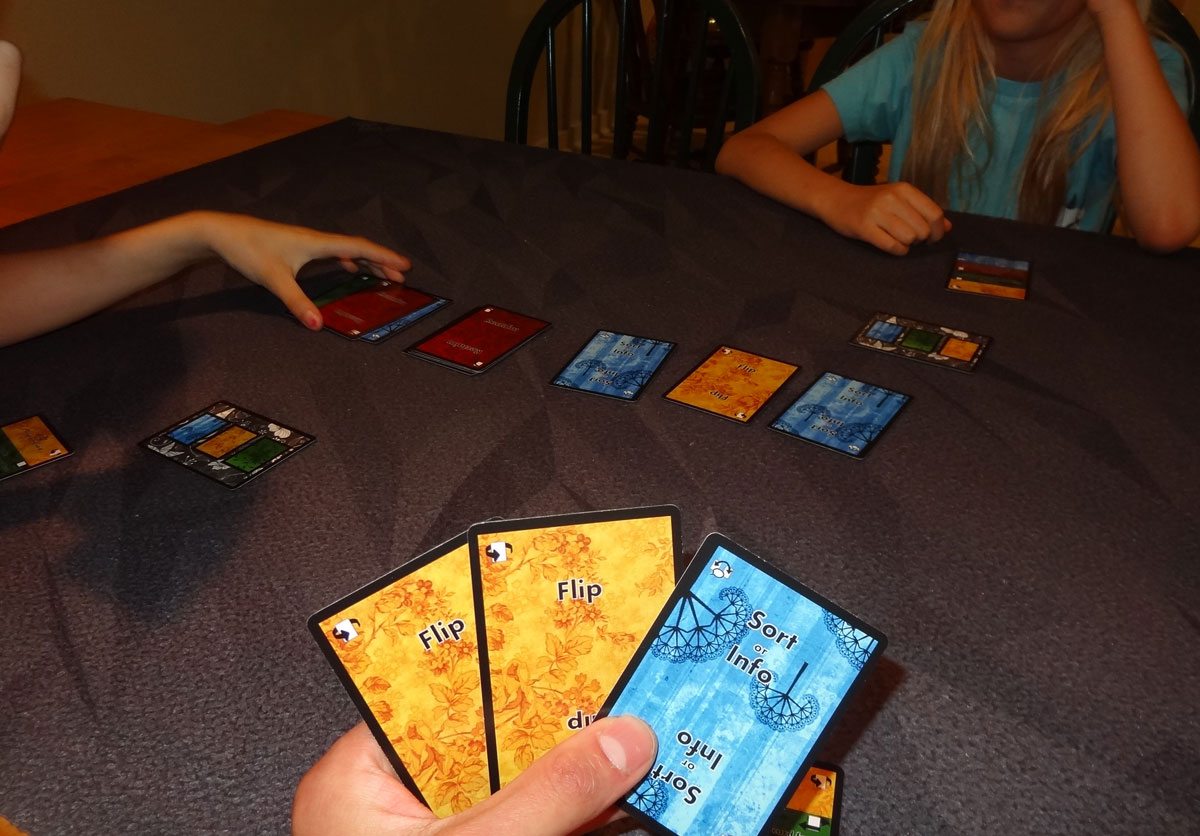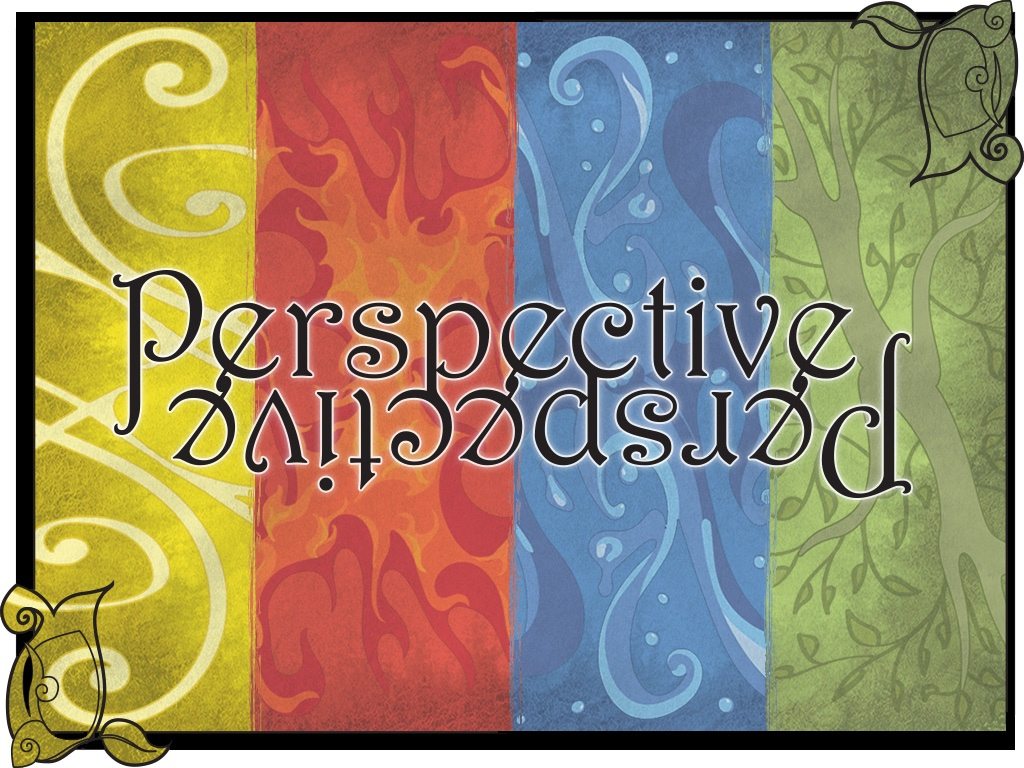Do you ever feel like everyone knows more than you do? Or like everything has gotten turned around? Maybe you just need a little Perspective.
At a glance: Perspective is a small card game designed by Andrew Voigt for 2 to 4 players, ages 9 and up, and takes about 15 minutes to play. It is currently seeking funding on Kickstarter, with a pledge level of $10 for a copy of the game. I’ve played it with both adults and my kids, and I think you could go younger than 10, though they do need to have fairly good memory and deductive skills. Note: the campaign is only running for 2 weeks, so if you’re interested, check it out soon!
New to Kickstarter? Check out our crowdfunding primer.

Components:
I received a prototype copy for review; exact components may be subject to change.
- 1 Player Aid card
- 6 Objective cards
- 20 double-sided cards

The double-sided cards have a color (red, blue, green, or yellow) and a patterned background, with an icon in two corners and an action (printed twice so the cards can be oriented either way). The backs of the cards have the same four colors, but there are different combinations. So a card may be blue on one side and green on the other, or blue on both sides, etc.

(Prototype shown) Photo: Jonathan H. Liu
The objective cards simply show three different colors in a row, and these are also double-sided with a different goal on the back. The summary card has a slightly more detailed explanation of each action, though these are fairly easy to learn.
Overall the cards serve their purpose but aren’t especially attractive; I don’t know if the font or icons will undergo any further refinement before publication. The one thing that might be nice is to add some icons or text on the goal cards for color blind players, but the patterned backgrounds may be obvious enough that it’s already sufficient.
How to Play
The goal of the game is to get the back of your hand of cards to match your objective card. The game changes slightly based on the number of players; for 4 players, you play with partners and both of you must achieve your objective to win.
Deal each player an objective card on the table in front of them, and give everyone a hand of 3 cards. The rest of the cards form the deck, with room for the “used” pile next to it. When the deck runs out, rather than shuffling the used pile, the top card becomes the new used pile and the rest of the used pile is flipped over and becomes the new deck. For 2 or 3 players, you also deal out a “shared hand” of three cards to the table–these cards count as every player’s “partner hand.”
When you play, the “front side” of a card is the side that you can see. When you draw cards from the deck, the side on top becomes the front, so you don’t see the back (but other players do). When you play a card, you play it front-side up, so you still don’t see the back. You may not rearrange cards in your hand except with an action.

(Prototype shown) Photo: Jonathan H. Liu
On each turn, you draw a card, placing it anywhere in your hand. Then you play a card from your hand into the used pile, and then take its action. The four actions are:
- Blue: Sort/Info–Either rearrange the cards in your hand, or ask what color the back of one card is. (In team play, you may rearrange a partner hand or tell one color instead of your own.)
- Yellow: Flip–Rotate one card in your hand or partner hand so that the front is now the back.
- Green: Trade–Trade one card from your hand with one card from partner hand (without changing the facing of either card).
- Red: Reclaim–Place a card from your hand (in addition to the Reclaim card) into the used pile, and then take any card from the used pile into your hand.
At any point during your turn (including between playing the card and taking the action) if you think you have achieved your objective, you may lay your hand face-down so you can see the backs of the cards. If the backs of your card match the color and order shown on your objective card, you win! If not, then you are eliminated and your cards are placed into the used pile.

(Prototype shown) Photo: Jonathan H. Liu
There is a two-player advanced variant in which the shared hand is the objective, so as the shared hand changes, the objective also changes.
I’ve been told also that there are solo rules in development but I have not played that yet–but it’s something to keep in mind if you like solo games.
The Verdict
Perspective reminds me a little of another game with double-sided color cards: FlipOut, which was released in 2011 by Gamewright. (You can read my review here.) Like Perspective, you didn’t always know what was on the back side of your cards. However, you scored based on the side you could see, so that made it a little easier. Also, you had a set of actions to choose from every turn, rather than being limited to actions based on the card you played.
In Perspective, your objective has to do with the back of your card, so you have to rely on memory and logic to get the right cards into the right places–and if you make a mistake, you won’t know until you lay down your cards and either win or are eliminated. I’m not a huge fan of player elimination, but at least Perspective is fairly short so you won’t be sitting out for too long if you guess incorrectly.
One of the tricky things about Perspective (and there are many) is that, until you’ve got your solution, you have to draw a card and play a card. So even if you’ve gotten the correct three colors facing out and you just need to rearrange them, if you don’t draw a blue card that you can play on your next turn, you may end up having to trade cards or flipping one around, which sets you back.
It all takes a lot of careful planning, and having a good memory helps. Whenever an opponent plays a card, you’ve seen the back side of it, and then the front side when it’s put into the used pile. Remembering which is which can help you when you use a Reclaim action. Or if you’ve seen somebody trade a card with the shared hand, you can remember what’s on the back side so when you trade for that card you’ll already know what’s on the back.
There is some element of bluffing, too, because of course your opponents can immediately tell if you’re holding a winning hand, even if you can’t. In a partner game, I suppose you’ll start getting some signals from your partner (though strictly speaking table-talk shouldn’t be allowed), but in a 2 or 3 player game you have to keep a straight face when you look over and see that somebody’s cards already match their objective.
Overall, I’ve enjoyed Perspective. It’s different enough from FlipOut, particularly in that it’s a pocket-sized game with only 27 cards. I like the idea of information about your own cards that’s obvious to everyone but you, and it’s a nice, small set of actions to learn. If you’re in the market for a clever deduction game, Perspective is a great fit.
For more information about Perspective, visit the Kickstarter page.





